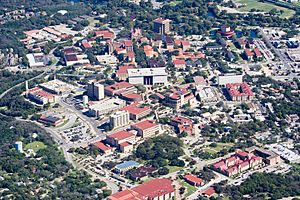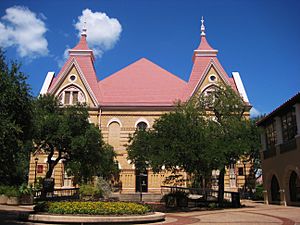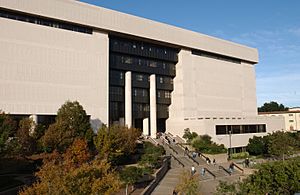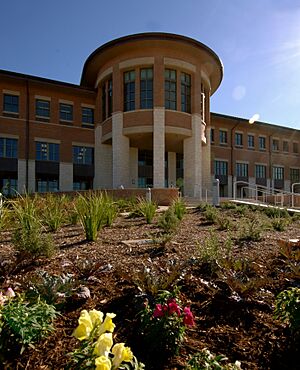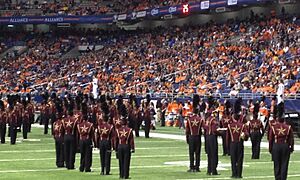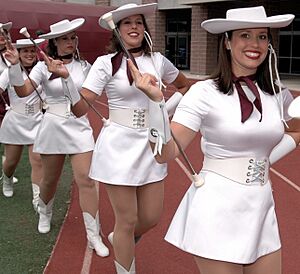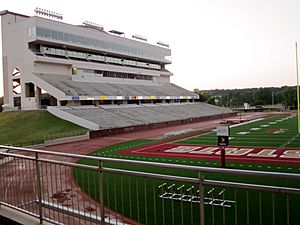Texas State University facts for kids
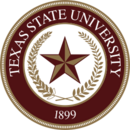 |
|
|
Former name
|
Southwest Texas State Normal School (1899–1918) Southwest Texas State Normal College (1918–1923) Southwest Texas State Teachers College (1923–1959) Southwest Texas State College (1959–1969) Southwest Texas State University (1969–2003) Texas State University-San Marcos (2003–2013) |
|---|---|
| Motto | Auctoritas Gravitas Humanitas Veritas (Latin) |
|
Motto in English
|
Prestige, Seriousness, Humanity, Truth |
| Type | Public research university |
| Established | 1899 |
|
Parent institution
|
Texas State University System |
|
Academic affiliations
|
|
| Endowment | $359 million (August, 2023) |
| President | Kelly Damphousse |
| Provost | Eugene Bourgeois |
| Students | 38,873 (Fall 2023) |
| Undergraduates | 34,872 (Fall 2023) |
| Postgraduates | 4,001 (Fall 2023) |
| Location |
,
United States
29°53′20″N 97°56′20″W / 29.88889°N 97.93889°W |
| Campus | 507 acres (205 ha) main campus 101 acres (41 ha) round rock campus |
| Colors | Maroon and Gold |
| Nickname | Bobcats |
|
Sporting affiliations
|
NCAA Division I – Sun Belt |
| Mascot | Boko the Bobcat |
 |
|
Texas State University (TXST) is a big public school. It has its main campus in San Marcos, Texas. There is also another campus in Round Rock. The university started in 1899. It has grown to be one of the largest universities in the United States. In Fall 2023, a record 38,873 students went to Texas State.
Texas State University offers over 200 different study programs. These include bachelor's, master's, and doctoral degrees. The school is known for its research. It is also a Hispanic-Serving Institution (HSI). This means it has a large number of Hispanic students.
The 36th president of the United States, Lyndon B. Johnson, went to this school. He graduated in 1930. Texas State University is the only college in Texas where a U.S. president studied.
The main campus in San Marcos is huge. It has 245 buildings on 507 acres of land. This land is hilly and runs along the San Marcos River. The Round Rock campus is 101 acres. The university also has a research park called STAR Park. It is 70 acres big. Texas State owns over 4,500 more acres for farms and recreation. The Forensic Anthropology Center at Texas State is the biggest forensics research place in the world.
Texas State University's sports teams are called the Bobcats. They play in National Collegiate Athletic Association (NCAA) Division I. They are part of the Sun Belt Conference.
Contents
History of Texas State University
Texas State University was first suggested in 1899. A state representative named Fred Cocke proposed it. It was called Southwest Texas State Normal School. Its goal was to train teachers. Students who finished could teach in public schools.
In October 1899, the city of San Marcos gave 11 acres of land for the school. This land was called Chautauqua Hill. In 1901, the state approved money for buildings. The first building, now called Old Main, was finished in 1903. The school opened with 303 students that September.
In 1912, the school partnered with San Marcos schools. This allowed Texas State students to practice teaching local children. By 1935, this became a formal agreement. The city's elementary and junior high schools became a "laboratory school" for the college.
In 1963, the first African-American students were allowed to enroll. This happened after a court case. A judge ruled that they could not be stopped from attending because of their race.
On November 8, 1965, Lyndon B. Johnson came back to his old school. He was president then. He signed the Higher Education Act of 1965 there. This law helped more people go to college. He shared how hard it was for him to afford college. He worked many jobs and lived in a small space.
In 1969, ten students were suspended. They were protesting the Vietnam War. They were called the "San Marcos 10." They fought their suspension in court. They were allowed to attend classes while the case went on. But in the end, they lost their case.
How the Campus Grew
The campus started with just 11 acres in 1899. Over the first 40 years, it grew a lot. It added 18 buildings around the original Main Building. These included classrooms, a library, and dorms.
In 1994, the university bought Aquarena Springs. This was a theme park next to the San Marcos River. It had glass-bottom boat rides. The school wanted to use it for research and education. It became the River System Institute in 2002.
In 1996, the school started offering classes in Round Rock, Texas. At first, it was just night classes for graduate degrees. In 2005, a new campus was built there. It was called the Texas State University Round Rock Campus. This happened after 101 acres of land were donated.
Changes to the School's Name
The school's name has changed many times.
- In 1918, it became Southwest Texas State Normal College.
- In 1923, it changed to Southwest Texas State Teachers College.
- In 1959, it was named Southwest Texas State College.
- Ten years later, in 1969, it became Southwest Texas State University.
In 2003, students asked to change the name again. They wanted it to be Texas State University at San Marcos. They felt the old name sounded too local. They wanted a name that showed it was a bigger university. The name became Texas State University–San Marcos. The city name was added to tell it apart from other schools.
In 2013, the city name was removed. The school had grown a lot in Round Rock. So, the name officially became Texas State University. This was the sixth name change in its history.
Explore the Campus
Texas State University has over 8 million square feet of buildings. Its campuses cover more than 600 acres. Plus, there are over 4,000 acres for farming, research, and fun.
The main campus is in San Marcos, Texas. It's between Austin and San Antonio. It covers 507 acres. This includes the original land given by San Marcos. The university also has the 101-acre Round Rock Campus. There is also a 70-acre Science, Technology, and Advanced Research (STAR) Park. Other areas for farming, recreation, and business cover over 4,500 more acres.
The Quad is the center of the main campus. Many academic buildings are around it. It's also where most university buses stop. Students gather here often. Student groups set up tables to promote events and fundraisers. On the west side of the Quad is a 17-foot tall sculpture. It shows two horses and is called The Fighting Stallions. This area is where students can freely express their opinions.
The main campus in San Marcos was used as a filming location. It was the fictional TMU (Texas Methodist University) in the TV show Friday Night Lights.
Old Main Building
Built in 1903, Old Main was the first building on campus. It was first called the Main Building. It looks like a red-gabled Victorian Gothic castle. It was added to the National Register of Historic Places in 1983. Over the years, it has been used for many things. It was once the main office building. Now, it holds offices for journalism and fine arts.
Alkek Library
The university's library is named after Albert B. Alkek. He was a former student who became an oilman and gave a lot of money. The Alkek Library is the main library for the university. It has many government documents from the U.S. and Texas. The library also has special collections. These include photos, archives of the TV show King of the Hill, and works by famous writers.
Sewell Park

Sewell Park is on campus, by the San Marcos River. It opened in 1917. Students first used it to learn swimming and for fun. In 1949, it was renamed Sewell Park. This was to honor S. M. Sewell, a math professor. He helped create the park.
A local legend, Dan Barry, also known as "Frisbee Dan," is often seen here. He throws his frisbee and watches over the park.
Round Rock Campus
The Round Rock Campus (RRC) is in Round Rock, Texas. It's about 20 miles north of Austin. It started in 1996 with a few classes in temporary buildings. In 2005, the Avery Building opened. It was designed to have classrooms, labs, offices, and a library all in one place. In 2010, a Nursing Building opened. Another health building, Willow Hall, opened in 2018.
The Round Rock Campus offers classes for the last two years of a bachelor's degree. It also has graduate degrees. Students can start at the San Marcos campus or a community college. Then, they can finish their degree at the RRC. Students who graduate from the Round Rock Campus get a degree from Texas State University.
Academics at Texas State
| Race and ethnicity | Total | ||
|---|---|---|---|
| White | 42% |
|
|
| Hispanic | 41% |
|
|
| Black | 10% |
|
|
| Other | 4% |
|
|
| Asian | 3% |
|
|
| Economic diversity | |||
| Low-income | 41% |
|
|
| Affluent | 59% |
|
|
In Fall 2018, Texas State University had 38,694 students. Most of them, 31,032, were undergraduate students. The rest were graduate students. The university accepts about 57.6% of new students. If you are in the top 10% of your Texas high school class, you are guaranteed acceptance.
About 55% of students are female. About 80% of students live off-campus. Around 10% of students are part of a fraternity or sorority.
University Rankings
| THES World | 1001-1200 |
|---|---|
| USNWR National University | 280 (tie) |
| Washington Monthly National University | 207 |
| Forbes | 418 |
In 2011, Military Times EDGE magazine said Texas State was the 13th best four-year school for veterans. In 2019, Washington Monthly ranked Texas State as 200th in the nation. The Princeton Review also included Texas State in its "Best 386 Colleges: 2021 Edition."
In 2023, U.S. News & World Report ranked Texas State 280th among national universities.
Colleges and Programs
Texas State University offers many degrees. There are 98 bachelor's programs, 93 master's programs, and 14 doctoral programs. The university has been approved by the Southern Association of Colleges and Schools since 1925.
These programs are offered through ten main colleges:
|
|
Research at Texas State
In 2012, Texas State University was named an "emerging research university". To get this title, a university must spend a lot on research. It also needs many doctoral students or degrees. Texas State has plans to get more money for its research.
One important research place is the Center for Research Commercialization. It focuses on environmental sustainability and biotechnology. This center helps university experts turn their research into new companies.
The Forensic Anthropology Center at Texas State is special. It is one of only seven places in the U.S. that studies human decomposition. It is the largest forensics research place in the world.
In 2012, the River Systems Institute was renamed The Meadows Center for Water and the Environment. This happened because of a $5 million donation. The center studies how water and the environment interact. This includes looking at springs and drought. They also study the San Marcos Springs and Spring Lake. These are the second largest springs in the Southwest U.S.
Many teachers at Texas State have won Fulbright Scholar grants. This means Texas State is a top university for Fulbright Scholars.
Fun Activities and Groups
Living on Campus
About 20% of Texas State students live in housing owned by the university. This includes about 95% of new students. In 2012, there were about 6,353 beds. Students can choose from traditional dorms or apartment-style housing.
Student Groups and Greek Life
Texas State University has over 300 student organizations. These include Greek groups, academic clubs, and sports clubs. There are more than 30 fraternities and sororities. These include groups for different cultures and interests. After a student died in 2017, all Greek life activities stopped for a while. They started again in 2018 with new rules.
Music, Government, and Performance
Bobcat Marching Band
The Bobcat Marching Band is the university's marching band. It is called "The Pride of the Hill Country." The band started in 1919. They perform at Texas State football games. They have also played at NFL games and two presidential inaugurations.
Student Government
The school's student government is made of students. They speak for all students to the university leaders. They work on issues like carrying weapons on campus and the school's no-smoking policy. They also manage a scholarship fund for students.
Honors Societies
Many honors societies are on campus. These include Golden Key and Alpha Chi National College Honor Society. Texas State was one of the first members of Alpha Chi in 1927. Texas State also has an active chapter of Alpha Phi Omega, a national service fraternity.
Texas State Strutters
The Texas State Strutters are a dance team. They started in 1960. They were the first of their kind at a four-year school in the U.S. They perform many dance styles. The Strutters have performed in 26 countries. They have been in two presidential inaugural parades and the Macy's Thanksgiving Day Parade. They were also on America's Got Talent.
Bobcat Build
Bobcat Build is a yearly community service event. It started in 2001. It is the biggest student-run service event at the university. Students and groups sign up to do service projects in San Marcos. This event has been praised by politicians.
Student Media
The oldest student media at Texas State was a yearbook. It was first published in 1904. It recorded events with photos and articles. It stopped being printed in 2000.
Now, the student newspaper is called the University Star. It covers news, trends, opinions, and sports. It is published every Tuesday during the school year. The Star also has a website with videos, blogs, and podcasts. The Star and its staff have won many awards.
Texas State's FM radio station is KTSW. It broadcasts at 89.9 MHz. It covers Texas State sports and plays independent music. The KTSW website has live broadcasts. KTSW's morning show, Orange Juice and Biscuits, has won awards.
Sports and Athletics
Texas State plays at the NCAA Division I level. They are part of the Sun Belt Conference. Texas State teams and athletes have won many championships. Some have even won medals in the Olympic Games.
Mascot and Logo
In 1920, Texas State chose its first mascot, the bobcat. Oscar Strahan, the athletic director, suggested it. He said bobcats are from central Texas and are fierce. The bobcat got a name in 1964. Beth Greenlees won a contest with the name Boko the Bobcat. The sports logo is called the SuperCat logo. A student designed the current version in 2003. In 2009, "Texas State" lettering was added to the logo.
Sports Rivalries
Texas State used to have a rivalry with Nicholls State University. It lasted for 13 years. It started in 1998 when a football game was postponed due to floods. To remember those affected, a wooden oar was made. The winning school would keep the oar. This was called the Battle for the Paddle. The rivalry ended in 2011 because Texas State changed sports conferences.
The rivalry with the University of Texas at San Antonio (UTSA) is called the I-35 Showdown. This is because Interstate Highway 35 connects the two cities. A trophy that looks like an I-35 sign is given to the winner. This tradition started with men's basketball. Now, it includes all sports between the two schools.
Texas State's in-state rival in the Sun Belt Conference was the University of Texas at Arlington (UT Arlington). This rivalry continued even when both schools moved to different conferences. But in 2022, UT Arlington moved back to the Western Athletic Conference.
Moving to FBS Football
In 2007, the university decided to try and move its football team to the Football Bowl Subdivision (FBS). This is a higher level of college football. Students voted to raise fees to help pay for this move. Almost 80% of students approved a $10 fee increase over five years.
The university also made improvements to its football stadium, Bobcat Stadium. They doubled the seating to 30,000. They also added luxury boxes and improved the press box.
Famous People Who Went to Texas State
- Notable people
-
Paul Goldschmidt
7-time MLB All-Star -
Robert L. Rutherford
General, United States Air Force -
George Strait
Country music singer -
Ricky Wayne Sanders 2× Super Bowl champion (XXII, XXVI)
The most famous person to graduate from Texas State University is U.S. president Lyndon B. Johnson. He went to the university from 1926 to 1930. It was called Southwest Texas State Teachers College then. He was on the debate team and edited the student newspaper. Johnson is the only U.S. president who graduated from a university in Texas.
Another famous former student is Grammy Award-winning country music singer George Strait. He graduated in 1979 with a degree in agriculture. He performed his first show with his band, the Ace in the Hole Band, in San Marcos. In 2006, the university gave him an honorary degree.
Other notable alumni include:
- Devon Walker, a comedian from Saturday Night Live.
- General Robert L. Rutherford from the United States Air Force.
- Musician Scott H. Biram.
- Actor Powers Boothe.
- Writer Tomás Rivera.
- Columnist "Heloise" (Ponce Cruse Evans).
- Baseball player Paul Goldschmidt for the St. Louis Cardinals.
- Professional wrestler Lance Archer (Lance Hoyt).
- Texas musician Charlie Robison.
See also
 In Spanish: Universidad Estatal de Texas para niños
In Spanish: Universidad Estatal de Texas para niños


